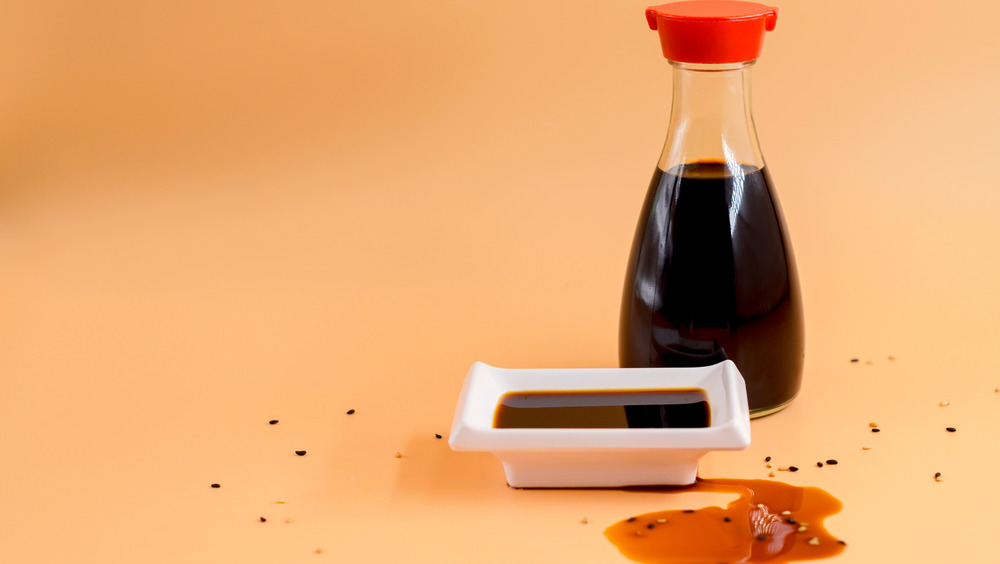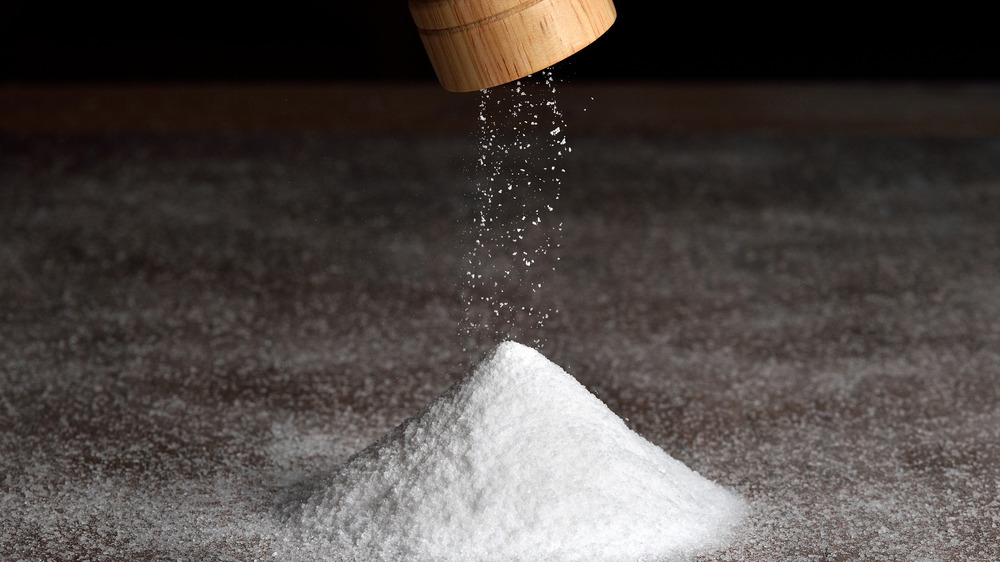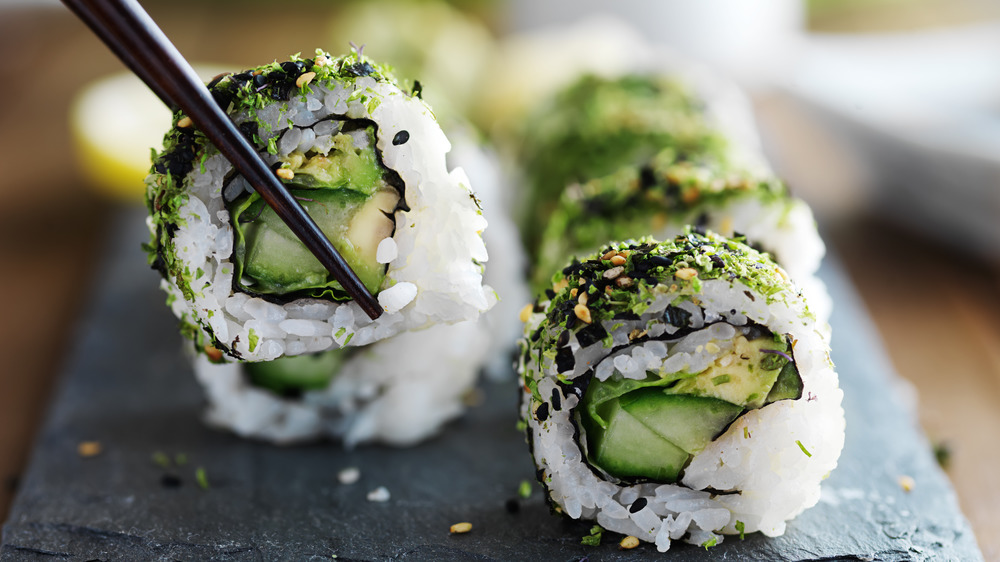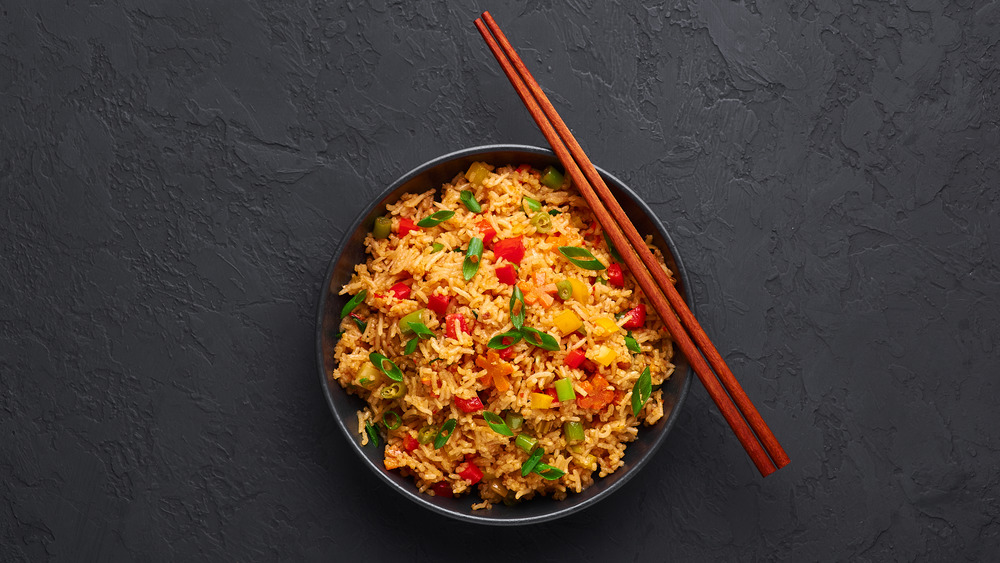You Should Never Put Soy Sauce On Fried Rice. Here's Why
If you're a fan of sushi or have eaten in a Chinese or Japanese restaurant, you're familiar with soy sauce. The brown, salty condiment that tastes good on everything from your dragon roll to a hibachi plate is created by fermenting soybeans. The result is a savory, umami flavor that's hard to beat (via The Spruce Eats).
Although it's deliciously versatile, soy sauce sometimes gets a bad rap for its sodium content, but low-sodium versions of this condiment are available if needed. Looking through the grocery shelves, you may have noticed there are several types of soy sauce, including the standard soy sauce, light, and dark soy sauce. Each version has a different sodium content, with dark containing the most sodium at 9.3 percent and light containing 7.2 percent, according to RecipeTin Eats. Some chefs claim that soy sauce is the secret ingredient they use in place of salt in many of their favorite recipes such as scrambled eggs, barbecue marinades, and smoked meats. So, why shouldn't you add soy sauce to fried rice?
Adding soy sauce to fried rice is, well, rude
Besides the added sodium, according to Delish, adding soy sauce to fried rice in a Chinese restaurant is actually considered offensive to the chef. Professional chefs have been trained to create a perfectly-seasoned dish. So, when diners add salt, or in this case, soy sauce, it's seen as an insult to their work.
Normally, a simple rule of etiquette is to avoid asking for salt if none is provided for you on the table (via Tasting Table). However, soy sauce is almost always on the table at Chinese and Japanese restaurants. And in the case of fried rice, the soy sauce might already be cooked into it (via MasterClass). So, use your judgment and taste the fried rice before deciding if it needs more soy sauce. Sometimes, adding soy sauce can feel automatic since it's there on the table, but a quick taste will confirm if more is needed or not.
Soy sauce is high in sodium and contains gluten
The daily recommended sodium intake for adults is 2,300 milligrams. According to Fat Secret, one cup of fried rice averages 800 milligrams of sodium, before any extra soy sauce. Each tablespoon of standard soy sauce contains 900 milligrams of sodium (via Health). Using these numbers, if you were to eat two cups of fried rice and add one tablespoon of soy sauce, you'd consume 2,500 milligrams of sodium. Too much salt in a diet can lead to a host of health problems, including high blood pressure and even stroke. But high sodium and bad etiquette aren't the only reasons to avoid adding soy sauce to your bowl of fried rice.
You may also be surprised to hear that soy sauce is usually not gluten-free. Unless you specifically choose a gluten-free soy sauce, the majority of soy sauces on the market are made by combining soy and wheat, meaning they are not gluten-free, according to Healthline. If you want to avoid gluten, look for soy sauces that use rice in lieu of wheat.
Vegans may want to think twice about soy sauce
There are recipes out there for vegans who love fried rice (via Simple Vegan Blog), but they may incorporate soy sauce. Over the years, there's been a debate about the suitability of soy sauce for vegetarians and vegans. According to Spoon University, years ago, soy sauce maker Kikkoman got in hot water over animal testing. Kikkoman ended the practice in 2015 and stated the following in a post on the company Facebook page: "When alternative testing methods are not possible, we strictly follow animal welfare laws and official guidelines established in Japan." Spoon University adds that most soy sauces are indeed vegan.
Not surprisingly, some vegans are still wary of soy sauce. Everything Vegan advises consumers to check with the manufacturer or make their own soy sauce if they want to truly steer clear of animal products. However, Thrive Cuisine says there are no animal products in soy sauce, including during the manufacturing process. Some have questioned the addition of lactic acid during fermentation, but Thrive Cuisine assures vegan consumers that lactic acid is just bacteria and just as vegan as yeast. And there's no dairy in soy sauce. Still worried? You have options.
Substitutes for soy sauce
If you adore the taste of soy sauce on homemade fried rice but are looking for a way to avoid gluten or possible animal ingredients, there are soy sauces on the market that are clearly labeled as gluten-free and/or vegan. But you still run into the problem of extremely high salt content. Another alternative is to try coconut aminos. Made from fermented coconut palm, coconut aminos has less than a third of the sodium contained in regular soy sauce and is lighter than light soy sauce. It also provides a gluten-free and vegan alternative (via PureWow). (It's not "low" in sodium, but it's definitely lower than the alternative.)
If you don't have allergies, and you're just looking for that elusive umami flavor and don't care where the flavor comes from, MasterClass suggests roasting your vegetables, adding mushrooms, fish sauce, or miso paste, or topping a dish with roasted seaweed. They'll all deliver that salty, savory fifth taste that you're craving.




